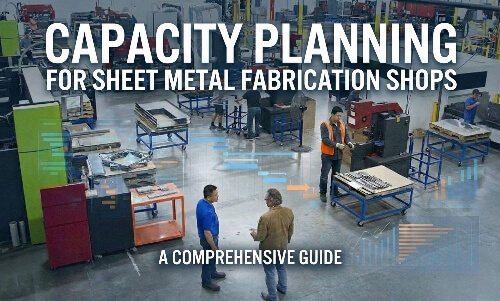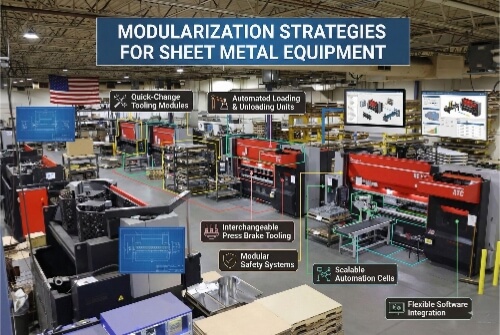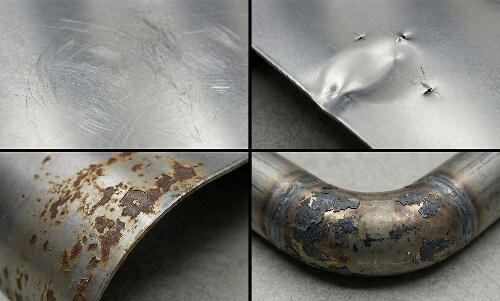Stainless steel manufacturers face a constant challenge: creating complex shapes without compromising material integrity. Traditional methods often fall short, leading to wasted resources and subpar products. Deep drawing offers a solution, but many struggle to harness its full potential.
Deep drawing transforms flat stainless steel sheets into three-dimensional shapes without welding or joining. This technique creates seamless, durable parts for various industries. It excels in producing cylindrical, box-shaped, or irregularly formed components with exceptional precision and efficiency.
Let’s explore how deep drawing works, its unique challenges, and its remarkable benefits to stainless steel manufacturing.
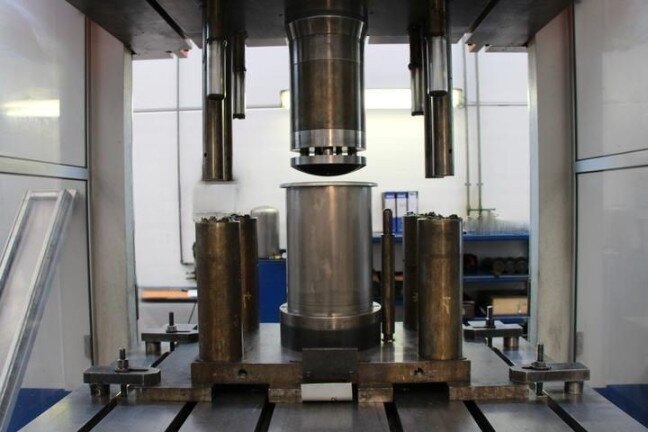
Understanding the Stainless Steel Deep Drawing Process
What is Deep Drawing?
Deep drawing reshapes flat metal sheets into hollow, three-dimensional forms. This process stretches the material over a die, creating complex shapes without seams or joints.
Steps Involved in Deep Drawing Stainless Steel
The deep drawing process follows a series of carefully controlled steps:
- Blanking: We cut the stainless steel sheet to size.
- Lubrication: We apply a specialized lubricant to reduce friction.
- Drawing: The blank is pulled over the die by a punch.
- Redrawing: For complex shapes, we may repeat the drawing process.
- Trimming: We remove excess material for the final product.
Required Equipment for Deep Drawing
Successful deep drawing relies on precise machinery:
- Hydraulic or mechanical presses
- Custom-designed dies and punches
- Blank holders to control material flow
- Specialized lubricants
The Role of Lubrication in Deep Drawing
Proper lubrication is crucial. It reduces friction between the metal and the die, preventing tearing and ensuring a smooth finish. We select lubricants based on the specific stainless steel grade and desired shape.
Material Considerations for Deep Drawing Stainless Steel
Key Properties of Stainless Steel for Deep Drawing
Stainless steel’s unique properties make it ideal for deep drawing:
- Ductility: Allows for significant deformation without fracturing.
- Work hardening: Strengthens the material during the drawing process.
- Corrosion resistance: Maintains integrity in harsh environments.
- Aesthetic appeal: Produces attractive, high-quality finished products.
Common Grades of Stainless Steel Used in Deep Drawing
Not all stainless steel grades are created equal for deep drawing:
- 304: Excellent formability and corrosion resistance.
- 316: Superior strength and chemical resistance.
- 301: High flexibility, ideal for complex shapes.
- 430: Good formability in ferritic stainless steel.
We select the appropriate grade based on the specific application requirements.
Common Applications of Deep Drawn Stainless Steel Components
Deep drawn stainless steel finds use in diverse industries:
- Automotive: Fuel tanks, exhaust components
- Aerospace: Engine parts, structural components
- Medical: Surgical instruments, implants
- Food processing: Sinks, containers, mixing bowls
- Consumer goods: Cookware, appliance housings
The versatility of deep drawn stainless steel continues to expand its applications.
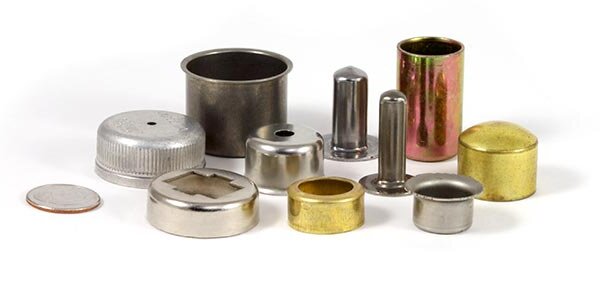
Tools and Equipment for Deep Drawing
Deep drawing stainless steel requires specialized tools and equipment. Let’s break down the key components you’ll need for successful deep drawing operations.
Presses Used in Deep Drawing
Hydraulic and mechanical presses are the workhorses of deep drawing. Hydraulic presses offer precise control and adjustable speed. They’re ideal for complex parts and small production runs.
Mechanical presses, on the other hand, excel in high-volume production. They provide faster cycle times and consistent force.
Dies and Punches: Design and Material Selection
Dies and punches are crucial in shaping stainless steel during deep drawing. Die design significantly impacts the final product quality. A well-designed die ensures proper material flow and prevents defects like wrinkling or tearing.
Material selection for dies and punches is equally important. Tool steels like D2 or M2 are common choices. They offer excellent wear resistance and maintain their shape under high stress. Carbidide tools might be necessary for more demanding applications.
Importance of Tool Maintenance in Deep Drawing
Regular tool maintenance is essential for consistent results in deep drawing stainless steel. Proper care extends tool life and ensures part quality.
Clean tools after each use to remove debris and prevent buildup. Lubricate moving parts regularly to reduce friction and wear. Sharpen or replace worn punches and dies promptly.
Techniques to Optimize Deep Drawing Performance
Mastering deep drawing techniques is crucial for achieving high-quality stainless steel parts. Let’s explore some key strategies to enhance your deep drawing process.
Controlling Material Flow and Thickness
Proper material flow is vital in deep drawing. It ensures uniform thickness and prevents defects. Use draw beads to control material flow into the die cavity. These raised areas on the die or blank holder create resistance, slowing material movement.
Lubrication plays a big role in material flow. Choose lubricants specifically designed for stainless steel. They reduce friction and heat buildup during drawing.
Monitor material thickness during drawing. Adjust punch speed and blank holder force as needed. This helps prevent excessive thinning or thickening in critical areas of the part.
Reducing Wrinkling and Tearing in Deep Drawing
To reduce wrinkling, optimize blank holder pressure. Start with lower pressure and gradually increase it. This allows controlled material flow while preventing excess material from bunching up.
To prevent tearing, consider multi-stage drawing for complex parts. This distributes the deformation over several steps, reducing stress on the material. Use generous corner radii on punches and dies. Sharp corners create stress points that can lead to tearing.
The Impact of Blank Holding Force on Final Product Quality
Blank holding force significantly affects the final product quality. Too little force leads to wrinkling, while too much can cause tearing. Finding the right balance is key.
Start with a lower blank holding force and gradually increase it. Monitor the part quality at each step. Look for signs of wrinkling or tearing and adjust accordingly.
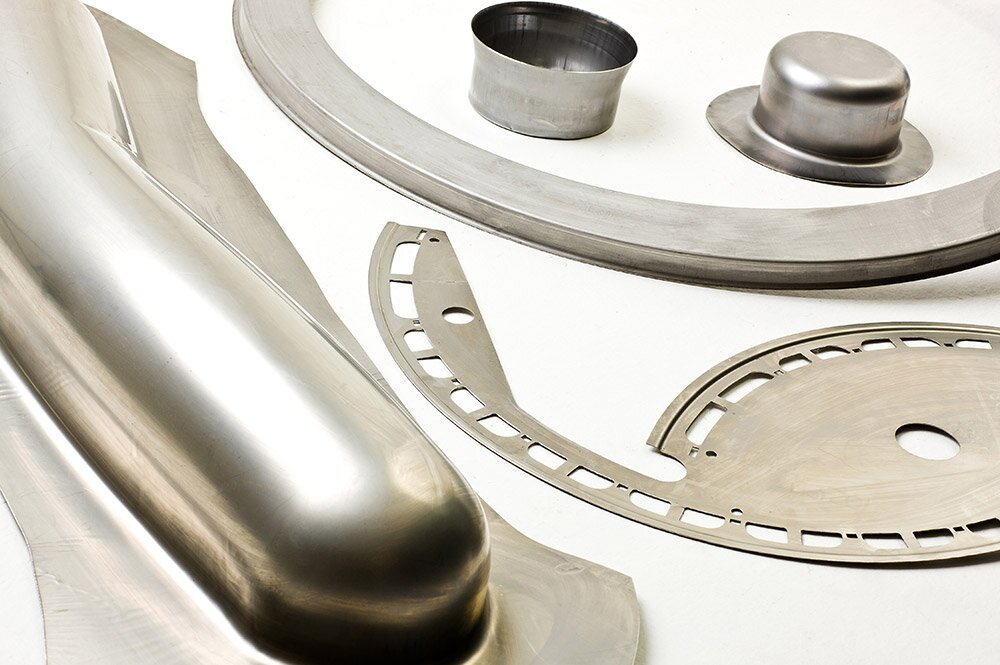
Benefits of Deep Drawing Stainless Steel
Deep drawing stainless steel offers numerous advantages. Let’s explore the key benefits that make this process a top choice for many manufacturers.
Cost Efficiency of Deep Drawn Stainless Steel Parts
Deep drawing offers significant cost advantages:
- Minimal material waste compared to machining processes
- High production speeds for large-volume orders
- Reduced need for secondary operations like welding or joining
- Lower tooling costs for simple shapes compared to other forming methods
These factors combine to make deep drawing a cost-effective choice for many applications.
Durability and Strength of Deep Drawn Stainless Steel Components
Deep drawn stainless steel parts boast impressive mechanical properties:
- Uniform wall thickness ensures consistent strength
- Work hardening during the process increases material strength
- Seamless construction eliminates weak points found in welded assemblies
- Excellent fatigue resistance for long-lasting performance
These characteristics make deep drawn parts ideal for demanding applications.
Environmental and Sustainability Advantages
Deep drawing aligns with sustainable manufacturing practices:
- Minimal material waste reduces raw material consumption
- Energy-efficient process compared to machining or casting
- Recyclability of stainless steel at end-of-life
- The long lifespan of products reduces replacement frequency
By choosing deep drawn stainless steel, manufacturers can reduce their environmental footprint.
Challenges in Deep Drawing Stainless Steel
Deep drawing stainless steel comes with its own set of challenges. Let’s explore common issues and how to address them effectively.
Common Defects in Deep Drawing Stainless Steel
Stainless steel’s properties can lead to specific defects during deep drawing. Understanding these issues is the first step in preventing them.
Wrinkling
Wrinkling occurs when excess material gathers in the drawn part’s flange or wall. It’s often caused by insufficient blank holder pressure or improper lubrication. Wrinkles can compromise the part’s structural integrity and appearance.
Tearing
Tearing happens when the material is stretched beyond its limits. It’s usually seen at the base or corners of deep-drawn parts. Excessive blank holder pressure or sharp tool edges are common culprits. Tears render parts unusable and increase scrap rates.
Earing
Earing is the formation of wavy edges on the top of deep-drawn cups. It’s caused by anisotropy in the stainless steel sheet. Earing leads to uneven part heights and can necessitate additional trimming operations.
How to Mitigate Deep Drawing Defects
Preventing defects requires a multi-faceted approach. Start by optimizing your tool design. Use simulation software to predict and address potential issues before production begins.
Fine-tune your process parameters. Adjust blank holder force, punch speed, and lubrication to find the sweet spot for each part. Use draw beads or step plates to control material flow and reduce wrinkling.
For complex parts, multi-stage drawing can help distribute stress more evenly. This reduces the risk of tearing and allows for deeper draws. Anneal the material between stages if necessary to restore flexibility.
Stainless Steel’s Impact on Tool Wear and Tear
Stainless steel is harder on tools compared to milder metals. Its high strength and work hardening properties accelerate tool wear. This leads to more frequent tool maintenance and replacement.
Combat tool wear by selecting appropriate tool materials. High-speed steels or carbides offer better wear resistance. To extend tool life further, apply hard chrome plating or nitriding.
Proper lubrication is crucial. Use lubricants designed for stainless steel deep drawing. They create a barrier between the tool and the workpiece, reducing friction and wear.
Deep Drawing vs. Other Metal Forming Processes
Choosing the right metal forming process is crucial for efficient production. Let’s compare deep drawing to other methods and explore when it’s the best choice for stainless steel components.
Comparing Deep Drawing to Stamping and Hydroforming
Deep drawing, stamping, and hydroforming each have unique strengths. Understanding these differences helps you select the most suitable process for your project.
Deep drawing excels at creating deep, cylindrical parts from flat sheet metal. It’s ideal for producing cups, cans, and other hollow forms. The process allows for tight tolerances and smooth surface finishes.
Stamping is great for the high-volume production of simpler shapes. It’s faster than deep drawing but limited in the depth and complexity of parts it can produce. Stamping works well for flat or shallow components like brackets or panels.
Hydroforming uses fluid pressure to shape metal. It’s versatile and can create complex shapes with uniform wall thickness. However, it’s typically slower and more expensive than deep drawing or stamping.
When to Use Deep Drawing for Stainless Steel Components
Deep drawing is often the go-to choice for stainless steel parts with specific characteristics. Consider deep drawing when you need:
- Deep, hollow parts: Deep drawing is likely your best option if your component has a depth greater than half its diameter.
- Tight tolerances: Deep drawing can achieve tighter tolerances than many other forming methods, which is crucial for precision components.
- Smooth surfaces: The process produces parts with excellent surface finish, reducing the need for secondary operations.
- Material efficiency: Deep drawing typically uses less material than machining processes, making it cost-effective for larger production runs.
- Complex geometries: While more versatile than hydroforming, deep drawing can produce more complex shapes than simple stamping.
Conclusion
Deep drawing stainless steel is a powerful manufacturing process with wide-ranging applications. It offers unique advantages in producing complex, durable parts efficiently.
This technique allows for creating seamless, hollow components with excellent strength-to-weight ratios. It’s particularly valuable in industries requiring high-performance, corrosion-resistant parts.
Do you need a reliable sheet metal parts manufacturer? Shengen is the place to go. We specialize in deep drawing, sheet metal laser cutting, stamping, surface finish, and CNC Machining. Reach out to Shengen Today and seek help from professionals!
FAQs
What maximum depth can be achieved in deep drawing stainless steel?
Typically, a 2:1 depth-to-diameter ratio is achievable in a single draw. Multiple stages can achieve ratios of 10:1 or higher. The exact limit depends on the steel grade and thickness.
How does stainless steel grade affect the deep drawing process?
Austenitic grades (304, 316) are easier to draw deep due to flexibility. Ferritic grades (430) are more challenging and may need additional annealing. Martensitic grades are the most difficult due to high strength and low ductility.
What is the maximum thickness for deep drawing?
The maximum thickness usually ranges from 3 to 4 mm (0.12 to 0.16 inches), varying based on steel grade and part geometry. Thicker materials require more force and specialized equipment.
What metal is best for deep drawing?
Low-carbon steels are often considered best due to their high ductility and low cost. Aluminum alloys (1000 and 3000 series) offer good formability and strength. The best choice depends on specific application requirements.
Hey, I'm Kevin Lee

For the past 10 years, I’ve been immersed in various forms of sheet metal fabrication, sharing cool insights here from my experiences across diverse workshops.
Get in touch

Kevin Lee
I have over ten years of professional experience in sheet metal fabrication, specializing in laser cutting, bending, welding, and surface treatment techniques. As the Technical Director at Shengen, I am committed to solving complex manufacturing challenges and driving innovation and quality in each project.

